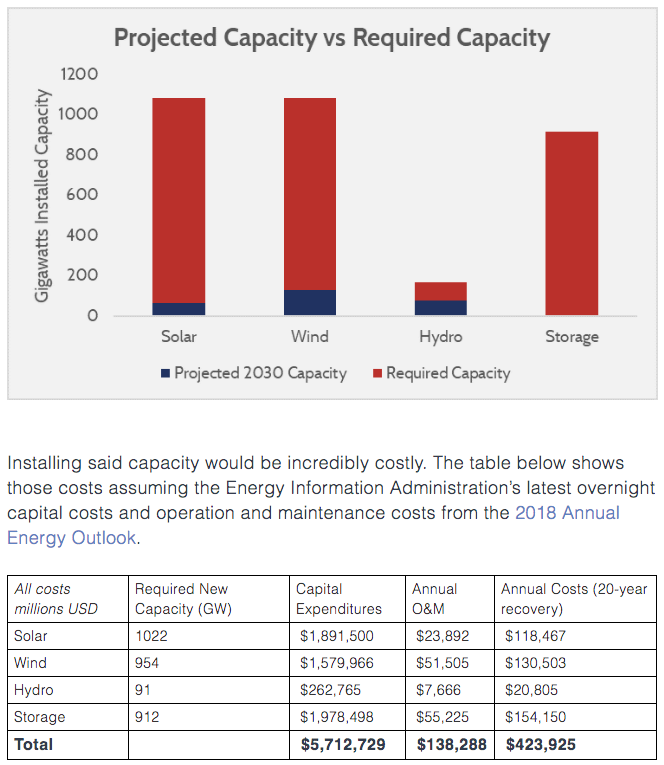There are several studies that indicate it would cost the United States trillions of dollars to transition to an electric system that is 100-percent renewable. Costs range from $4.5 trillion by 2030 or even 2040 to $5.7 trillion in 2030—about a quarter of the U.S. debt. The lower estimate results in a cost per household of almost $2,000 per year through 2040. The $4.5 trillion cost does not include the stranded cost of the oil, natural gas, and coal technologies that would be disrupted. Costs can be greatly reduced by allowing nuclear as part of the non-carbon emitting mix and allowing natural gas to generate 20 percent of the electricity. Allowing existing nuclear plants to operate would save about $500 billion. Also, moving the goal to 2045 or 2050 would help to reduce costs by allowing advanced technologies to be developed and commercialized.
A spokesperson for Wood Mackenzie, who was in charge of one of the studies indicates, “In areas of the country that have a decent mix of wind and solar potential, those places can probably get to 50% renewables without struggling. Above 50%, the challenge of ensuring reliable grid operations starts to take off.” No large and complex power system in the world operates with an average annual wind and solar generation level greater than 30 percent. Another issue is that installers of wind turbines will be faced with NIMBY (not-in-my-back-yard) challenges.
Wood Mackenzie Study
The critical factor in 100-percent renewable energy with no nuclear power depends on the future of utility-scale battery storage. The firm estimated that 1,600 gigawatts of new wind and solar capacity would be required to replace all U.S. fossil fuel generation and 900 gigawatts of battery storage backup would be needed. There are only 5.5 gigawatts of battery storage world-wide in operation or under construction. If wind or solar replaced a 2-gigawatt nuclear power plant, and batteries provided the only backup, 6 to 8 gigawatts of battery storage would be required.
The U.S. power grid has about 1,060 gigawatts of total capacity, of which about 130 gigawatts is wind and solar capacity. One hundred-percent renewables by 2030 would require adding more wind and solar power in the next 11 years than the total capacity of these two sources installed in the past 20 years. The costs of new wind and solar units needed for a 100-percent renewables standard would be about $1.5 trillion. Adding the required battery storage would raise the cost to about $4 trillion and adding new transmission lines would increase the cost to $4.5 trillion. The United States currently has about 200,000 miles of high-voltage transmission. The report estimates that achieving 100 percent renewables would require doubling the transmission lines, which would add $700 billion to the total price. The cost estimate does not include additional supply chain costs that could result from the increased demand for steel, construction equipment, or other supplies.
An 80 percent carbon-free target with natural gas generation providing the other 20 percent would reduce new battery storage costs by 60 percent. Natural gas provides an important back-up fuel for solar and wind power, which are intermittent technologies and are not available when the sun is not shining and the wind is not blowing. Natural gas can be ramped up or down quickly, is abundant and low cost. As such, it has helped the U.S. generating sector reduce carbon dioxide emissions, which declined by 27 percent between 2005 and 2018.
American Action Forum Analysis
According to an analysis by the American Action Forum, the proposal to transition 100 percent of U.S. electricity production to renewable sources by 2030 would require at least $5.7 trillion of investment in renewable energy and storage. This is a ballpark estimate and not an in-depth projection, and may not include all the contingencies necessary to make the system work. The group also notes that it is likely to be a significant underestimation, as it reflects the lowest possible cost.
Assumptions of the analysis include:
• the United States would use solar power during the day, and wind power during the night;
• for the hours in the day where neither solar nor wind produce their stated capacity, a mixture of hydroelectricity and storage would be used;
• the United States would build the entirety of all potential hydroelectricity resources (a controversial issue with environmentalists and an objective that could not be completed by 2030);
• storage costs associated with batteries would be their average operation and maintenance cost, rather than the significantly higher costs of batteries that can discharge electricity quickly and repeatedly throughout the day;
• electricity demand will be roughly flat (rather than demand spiking during afternoon hours); and,
• there will be no increase in the price of wind, solar, hydroelectricity, or storage, despite the fact that demand for all of these sources would skyrocket due to such policy.

Conclusion
As these two studies indicate, a 100-percent renewable electricity system is not realistic by 2030 as the Green New Deal requires and certainly not at a reasonable cost. Wind and solar technologies are intermittent, as they depend on the weather and have low capacity factors, meaning that much more capacity would be required than the coal or natural gas capacity that they would be replacing. Further, battery storage is currently not a viable option as the technology is expensive and still developing.



